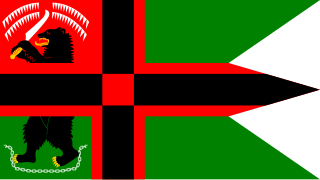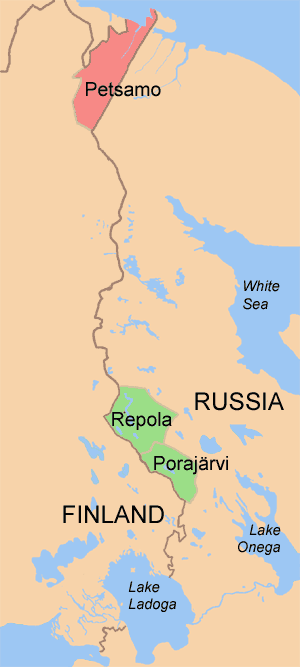
Paavo Juho Talvela was a Finnish general of the infantry, Knight of the Mannerheim Cross and a member of the Jäger movement. He participated in the Eastern Front of World War I, the Finnish Civil War, the Finnish Kinship Wars, the Winter War and the Continuation War.

Karelia is an area in Northern Europe of historical significance for Russia, Finland, and Sweden. It is currently divided between northwestern Russia and Finland.

The Viena expedition was a military expedition in March 1918 by Finnish volunteer forces to annex White Karelia from Soviet Russia. It was one of the many "kinship wars" (Heimosodat) fought near the newly independent Finland during the Russian Civil War. Russian East Karelia was never part of the Swedish Empire or the Grand Duchy of Finland. and it was at the time mostly inhabited by Karelians. However, many advocates of a Greater Finland considered these Karelians a "kindred" Finnish nation and supported the annexation of Russian East Karelia to Finland.

Reboly is a settlement in the Republic of Karelia of the Russian Federation by the Finnish border, located 91 kilometres (57 mi) southeast of Kuhmo and 96 kilometres (60 mi) northeast of Lieksa. In 1926 the settlement had a population of 1465, in 2010 - 258 people.

Forest Guerrillas were a East Karelian resistance movement that was created officially on 14 October 1921. There were around 3,000 Forest Guerillas in total during the East Karelian Uprising as a Karelian and Finnish resistance movement against Bolshevik Russia, aiming for an East Karelian state with independence from Russia, and in some occasions unification or cooperation with Finland. Most of the soldiers of the Forest Guerillas were from White Karelia, Repola & Porajärvi and Olonets Karelia. The heraldry of the East Karelian Forest Guerillas was created by Akseli Gallen-Kallela.
The Order of the Day of the Sword Scabbard, or the Sword Scabbard Declaration, actually refers to two related declarations by the Finnish Commander-in-Chief Carl Gustaf Emil Mannerheim during World War I and World War II against Soviet control of East Karelia.

Greater Finland, was an irredentist and nationalist idea that was a subset of Pan-Finnicism which emphasized the territorial expansion of Finland. The most common concept of Greater Finland saw the country as defined by natural borders encompassing the territories inhabited by Finns and Karelians, ranging from the White Sea to Lake Onega and along the Svir River and Neva River—or, more modestly, the Sestra River—to the Gulf of Finland. Some proponents also included the Torne Valley, Ingria, and Estonia.

The Finnish term Heimosodat refers to a series of armed conflicts and private military expeditions in 1918–1922 into areas of the former Russian Empire that bordered on Finland and were inhabited in large part by other Finnic peoples. The term has been translated into English as "Kindred Nations Wars", "Wars for kindred peoples", "Kinfolk wars", or "Kinship Wars," specifically referring to Finnic kinship. Finnish volunteers took part in these conflicts, either to assert Finnish control over areas inhabited by related Finnic peoples, or to help them gain independence from Soviet Russia. Many of the volunteers were inspired by the idea of "Greater Finland". Some of the conflicts were incursions from Finland, and some were local uprisings in which volunteers wanted either to help people fight for independence or to annex areas to Finland. According to Aapo Roselius, about 10,000 volunteers from Finland took part in the armed conflicts mentioned below.

Karelia has appeared in philately several times; first as a breakaway republic from Soviet Russia in 1922, later when Eastern Karelia was occupied by Finland during the Continuation War of 1941 to 1944, and in the post-Soviet period when provisional stamps and cinderellas were issued. Additionally, there were Zemstvo stamps used in the early 20th century on the territory of the contemporary Republic of Karelia.

The Treaty of Tartu was signed on 14 October 1920 between Finland and Soviet Russia after negotiations that lasted nearly five months. The treaty confirmed the border between Finland and Soviet Russia after the Finnish Civil War and Finnish volunteer expeditions in Russian East Karelia that resulted in annexation of several Russian districts.

The Karelian people's presence can be dated back to the 7th millennium BC–6th millennium BC. The region itself is rich with fish, lakes, and minerals, and because of that throughout history changed its holder, to this day divided between the Republic of Finland and the Russian Republic.

The East Karelian Uprising and the Soviet–Finnish conflict 1921–1922 were an attempt by a group of East Karelian separatists to gain independence from the Russian Soviet Federative Socialist Republic. They were aided by a number of Finnish volunteers, starting from 6 November 1921. The conflict ended on 21 March 1922 with the Agreements between the governments of Soviet Russia and Finland about the measures of maintenance of the inviolability of the Soviet–Finnish border. The conflict is regarded in Finland as one of the heimosodat – "Kinship Wars".

The Finnish invasion of East Karelia was a military campaign in 1941. It was part of the Continuation War. Finnish troops occupied East Karelia and held it until 1944. For over a month after the outbreak of the Continuation War, the Karelian Army reinforced and prepared to resume its earlier offensive while waiting for the recapture of the Karelian Isthmus. The Soviets had prepared fortifications and brought troops to the front. When encirclements on the western shore of Lake Ladoga were resolved, the Finnish 7th Division was transferred to the junction of VI and VII Corps.
The timeline of the Winter War is a chronology of events leading up to, culminating in, and resulting from the Winter War. The war began when the Soviet Union attacked Finland on 30 November 1939 and it ended 13 March 1940.

Porosozero is a rural locality in Suoyarvsky District of the Republic of Karelia, located along the Suna River. Municipally, it is a part and the administrative center of Porosozerskoye Rural Settlement of Suoyarvsky Municipal District. Population: 3,529 ; 4,406.

The Finnish military administration in Eastern Karelia was an interim administrative system established in those areas of the Karelo-Finnish Soviet Socialist Republic (KFSSR) of the Soviet Union which were occupied by the Finnish army during the Continuation War. The military administration was set up on 15 July 1941 and it ended during the summer of 1944. The goal of the administration was to prepare the region for eventual annexation by Finland.

The Republic of Uhtua, also Provisional Government of Karelia, officially called the Republic of East Karelia was an unrecognized state that existed from 1919 to 1920, formed out of five volosts in the Kemsky Uyezd of the Arkhangelsk Governorate.

The Karelian United Government was a short-lived state that existed from 1920 to 1923, as a merger of the Republic of Uhtua and the Olonets Government of Southern Karelia.

Iivo Ahava was a Karelian-born Finnish military officer and nationalist who supported the idea of an independent East Karelia. In the 1918 Finnish Civil War, Ahava led a Red Guard unit fighting against the Whites on their Viena expedition. During the Allied North Russia Intervention, Ahava served as a lieutenant in the British organized units of Murmansk Legion and Karelian Regiment. He was murdered in unclear circumstances in East Karelia.

Antti Isotalo was a Finnish Jäger lieutenant, military recruiter, farmer and activist. He served in the German Empire's battalion of Finnish volunteers on the Eastern Front of World War I and briefly in the Finnish Civil War (1918) on the Whites' side. He repeatedly evaded capture by authorities while recruiting men for the battalion in 1915 and 1916. After recovering from wounds sustained in the civil war, he recruited volunteers for the Estonian War of Independence and then joined the Aunus expedition as one of its commanders during Finland's "tribal wars" in 1919.

















